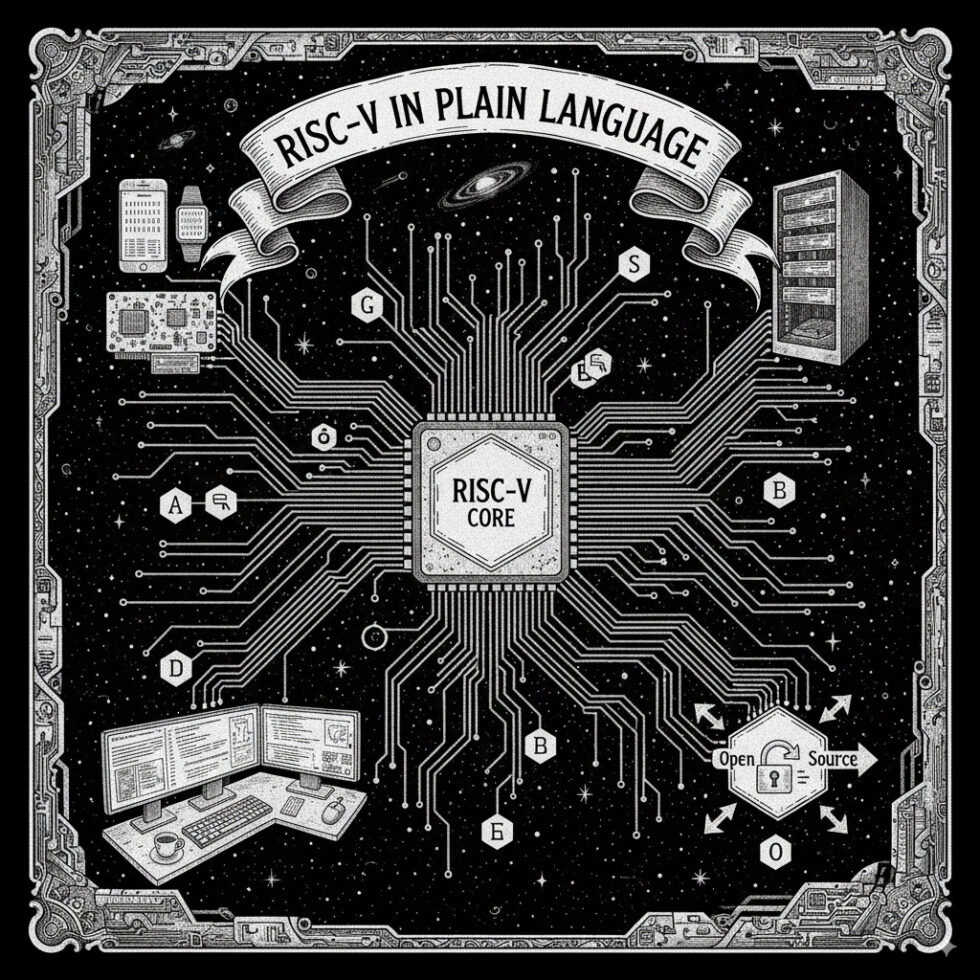
Chips are everywhere: in your phone, thermostat, car key, and even your toothbrush. Most of them share one thing in common—they follow a set of rules that tells hardware how to run software. Those rules are called an instruction set architecture, or ISA. For decades, ISAs were proprietary. Now there’s a different approach that is suddenly moving from labs into everyday products: RISC‑V, an open ISA that anyone can implement.
RISC‑V is often described as “open-source chips,” but that’s only half true. The openness lives in the specification for how instructions work, not in every chip made from it. That distinction matters because it’s what gives companies and creators more room to innovate—and you more choices as a buyer and developer. This article explains RISC‑V in clear language, shows where you’ll encounter it first, and offers practical advice to try it yourself without spending much money.
What RISC‑V Actually Is
ISA vs. CPU: the rulebook and the players
An ISA is like a language. It defines what instructions a processor understands (add, load, branch) and how they behave. A CPU is a particular design that speaks that language. With RISC‑V, the language is open and standardized, but different companies can design their own CPUs that implement it. Some designs are open; others are proprietary. The key point: software that targets the RISC‑V ISA can run on any conforming RISC‑V CPU.
Why RISC‑V matters now
- Freedom to implement: No per‑core royalties for using the ISA. That lowers cost and reduces lock‑in.
- Modularity: RISC‑V has a small, clean base plus extensions (e.g., for vectors, crypto, compressed instructions). You can build tiny controllers or powerful compute cores from the same instruction family.
- Customization: Companies can add custom instructions for tasks like AI or security while staying compatible with standard software.
- Growing software support: Compilers, operating systems, and toolchains have matured fast, making it practical for real products.
Where You’ll See It First
Everyday microcontrollers and IoT
The most visible shift is in low-cost microcontrollers that handle Wi‑Fi, sensors, and simple logic. For example, ESP32‑C3 modules from Espressif use a RISC‑V core to power budget-friendly Wi‑Fi/Bluetooth gadgets. For makers and startups, this means cheaper boards, familiar tools, and power budgets that fit wearables and small appliances.
Storage, networking, and controllers inside bigger systems
Many servers and PCs already pack multiple small processors that do specialized work—managing power, firmware, SSDs, or network cards. These often switch architectures faster than CPUs in your laptop. RISC‑V has taken root here because it’s easy to tailor and certify for narrow tasks. You won’t “see” it as a consumer, but you benefit indirectly through better efficiency, faster boot times, and improved firmware security.
Wearables, toys, and educational kits
Battery-powered devices need simple, efficient chips with good developer support. RISC‑V fits well: it scales down to tiny cores that sip power while still running modern toolchains. Educational boards using RISC‑V let students learn computer architecture with open documentation, not black-box PDFs.
Automotive and industrial control
Cars, robots, and factory systems use many microcontrollers for sensors and safety. Vendors like to customize their silicon and keep costs predictable over long product lifecycles. RISC‑V’s modularity and lack of ISA royalties help here, and functional safety toolchains are improving to meet automotive standards.
How the Software Stack Looks
Compilers and languages
The headlines: GCC and LLVM/Clang both support RISC‑V. That means C, C++, Rust, and more compile cleanly. Over the last two years, performance of generated code and support for new extensions have improved rapidly. For microcontrollers, you’ll also find familiar SDKs and RTOSes like FreeRTOS, Zephyr, and vendor libraries.
Operating systems
- Linux: RISC‑V is a first-class architecture in mainline Linux. Server-class cores with MMU and virtual memory can run standard distros.
- Embedded: RTOS options are rich, and bare‑metal development is common for tiny cores.
- Security software: Open projects such as OpenTitan (a silicon root of trust) adopt RISC‑V for transparency and auditability.
Tools and debugging
Open-source tools like OpenOCD, GDB, and QEMU already support RISC‑V. Commercial IDEs now include RISC‑V packs for stepping through code, analyzing power, and checking safety. For everyday developers, this means less friction and fewer exotic workflows compared to early days.
Performance, Power, and Extensions
How fast can it go?
“RISC‑V equals slow” was once a fair stereotype for hobby boards. That’s changing. The ISA itself doesn’t set speed; microarchitecture does. High-end RISC‑V cores now include out-of-order pipelines, large caches, and vector units. Early data shows competitive performance per watt for embedded and midrange applications, with server-grade designs arriving in pilots.
Vector and AI extensions
The RISC‑V Vector extension (RVV) lets one instruction operate on many data elements in parallel. It’s flexible: hardware can implement different vector lengths while software writes code once. That’s attractive for AI inference, signal processing, and graphics kernels. Some vendors also add custom matrix or tensor instructions; if they follow the extension rules, they can still run standard code while unlocking speedups in tuned libraries.
Power efficiency and right-sizing
Because the base ISA is small, implementations can be tiny and efficient—perfect for sensors and wearables. Or they can scale up with extensions for multicore systems. This “right-size the core” approach helps designers avoid paying for features they don’t need, which shows up as lower cost and longer battery life in devices.
Business Shifts Behind the Scenes
From royalties to membership and certification
With RISC‑V, companies don’t pay royalties per chip for the ISA. Instead, the ecosystem funds itself through membership fees, events, and compliance programs. Vendors still sell proprietary CPU designs, IP blocks, and chips, but they start from a common open rulebook. This model accelerates experimentation, especially for smaller companies and public research labs.
Customization without breaking everything
A common worry is fragmentation: if everyone adds custom instructions, won’t software break? The RISC‑V spec tackles this by defining standard extensions and naming rules for custom ones. Software can check the CPU’s features at runtime and choose code paths accordingly. Toolchains and OSes increasingly support this negotiated capability model, reducing the risk of incompatible islands.
Supply chain flexibility
Open standards can broaden supply options. Multiple foundries, IP vendors, and chipmakers can implement compatible cores. For device makers, that means second-sourcing and longer product lifetimes become easier. For developers, it means you can carry skills and code across products without starting from scratch.
Security: What Changes and What Stays the Same
Open specs help, but design still matters
An open ISA makes it possible for more eyes to review behavior and for independent teams to build verification tools. Projects like OpenTitan showcase how openness improves trust in root-of-trust silicon. But: security still depends on the quality of each implementation, how firmware is updated, and how keys are managed. RISC‑V does not magically fix insecure software or sloppy supply chains.
Trusted boot and isolation
Hardware features such as Physical Memory Protection (PMP), hypervisor extensions, and page-based protection enable robust isolation. Combined with a measured boot path and signed firmware, RISC‑V systems can meet enterprise security baselines. The ecosystem is also working on standardizing cryptographic extensions so that secure code runs consistently across vendors.
What This Means for Buyers and IT Teams
Compatibility: apps and OSes
Mobile and desktop app ecosystems don’t switch overnight. If you need to run a specific commercial app, check for RISC‑V support just as you would check ARM or x86 compatibility. For servers and embedded Linux, many open-source stacks already run on RISC‑V with minimal changes. For microcontrollers, the application is typically recompiled from source and uses standard libraries.
Procurement and lifecycle
Because the ISA is open, multiple vendors can supply similar capabilities. That can reduce single-vendor risk. Look for compliance badges, long-term support (LTS) promises, and a clear firmware update strategy. Ask vendors how they handle custom instructions: is there a fallback path? Are toolchains available off-the-shelf?
Cost and availability
RISC‑V doesn’t guarantee cheaper chips, but it often helps at the low end and in high-volume embedded products. Savings come from avoiding ISA royalties and right-sizing features. Availability benefits from broader supplier participation. Still, evaluate total cost of ownership: toolchain maturity, developer training, and certification may be part of the decision.
Getting Hands-On Without the Headaches
Starter boards and kits
- Wi‑Fi microcontrollers: Low-cost RISC‑V boards with wireless radios let you build sensors, home projects, and prototypes with standard SDKs.
- General-purpose dev boards: Boards that boot embedded Linux give you a playground for compilers, filesystems, and networking.
- Education kits: Some include soft cores you can simulate on your PC, so you can step through instructions and learn the ISA basics.
What to build first
- Sensor-to-cloud: Read temperature, post to a web service, and update over-the-air. You’ll test toolchains, Wi‑Fi, and secure firmware updates.
- Edge AI demo: Run a small keyword spotter or gesture recognizer with a vector-enabled core or DSP extension, comparing performance to a baseline.
- Secure boot flow: Implement signed firmware and a rollback policy. This exercise teaches the security building blocks that matter in the field.
Practical tips
- Pick a board with an active forum: Good docs and lively discussions save hours.
- Lock your toolchain: Use containerized builds or known-good versions to avoid surprises when extensions change.
- Measure power early: Small firmware changes can double battery life. Use a USB power meter or a dev board with current sensing.
Common Misconceptions, Cleared Up
“Open means free-for-all chaos”
RISC‑V is governed by a formal standards body with working groups, ratified extensions, and compliance tests. Vendors still compete on design quality, but not on opaque rules.
“It’s only for tiny devices”
While microcontrollers lead the pack, the roadmap includes performance-oriented cores with vector and hypervisor support. Linux servers and AI accelerators built around RISC‑V are moving from paper to production pilots.
“No apps will run”
For embedded systems, apps are compiled from source and run natively. For Linux and server use, package ecosystems are catching up, and many open-source projects already ship RISC‑V builds. Cross-compilation and containers further smooth the path.
Design Freedom: The Most Underrated Benefit
The biggest unlock is the ability to co-design hardware and software without renegotiating a license. If your product needs a quirky instruction to speed up cryptography or a fixed-point math routine, you can add it—then provide a library and compiler support for customers. That feedback loop makes devices feel more responsive, battery life stretch further, and costs drop at volume. For users, it translates to more specialized devices that still play well with standard tools.
What to Watch in the Next 24–36 Months
- Standardized AI libraries: Expect vendor-neutral math kernels that detect vector features and just work.
- More wireless SoCs: Wi‑Fi 6/6E and Bluetooth LE parts will expand, giving IoT builders more options.
- Security certifications: Formal validations for automotive and industrial safety will make RISC‑V easier to approve in regulated fields.
- Developer experience: IDEs, debuggers, and cloud CI pipelines will treat RISC‑V like any other first-class target.
- Hybrid systems: Mixes of RISC‑V controllers with other CPUs and accelerators will become normal on one board or even one chip.
A Short Buyer’s Checklist
- Does the chip or board pass RISC‑V compliance and list its standard extensions clearly?
- Is there LTS support for the SDK, drivers, and operating system?
- What’s the firmware update plan (signed updates, rollback protection, key rotation)?
- Can you source a second supplier if needed?
- Are there reference designs and sample code that match your use case?
Developer Quickstart: From Zero to Blinking LED
Step 1: Set up the toolchain
Install GCC or LLVM for RISC‑V and the board’s SDK. Most vendors provide installers for Windows, macOS, and Linux. Verify the compiler targets your board’s CPU and extensions.
Step 2: Flash a sample
Start with a proven example (LED blink or Wi‑Fi connect). Confirm UART output and make a small change to see your changes reflected.
Step 3: Add a library
Pull in a networking or sensor library. Write a minimal data pipeline: read, process, publish. Keep logs concise and add a watchdog to catch hangs.
Step 4: Optimize
Use the compiler’s optimization flags and check the generated size. Profile hot loops. If your chip supports vector or DSP extensions, try the vendor’s math kernels and compare power draw.
Why This Shift Feels Different
We’ve seen open standards reshape industries before: the Internet Protocol, HTML, USB. RISC‑V could play a similar role inside devices. It doesn’t replace the need for great chip design—far from it. But it does change the default assumptions about who can innovate and at what pace. When the rulebook is open, more players join the game. The results are already showing up in Wi‑Fi modules, storage controllers, and wearables, and they’re heading for bigger systems next.
Summary:
- RISC‑V is an open instruction set; it defines the rules, not one specific chip design.
- It shows up first in microcontrollers, wireless modules, storage controllers, and wearables.
- Toolchains like GCC/LLVM and OSes from RTOS to Linux already support it well.
- Modular extensions (vectors, crypto) enable both tiny and high-performance cores.
- Open standards reduce lock‑in and can improve supply chain flexibility.
- Security depends on implementation quality; open specs help with review and auditing.
- For buyers, check compliance, LTS, firmware update policies, and second sourcing.
- It’s easy to try: affordable dev boards, familiar tools, and active communities.





